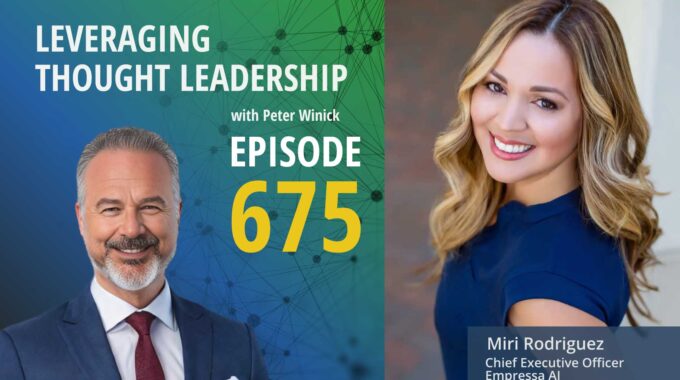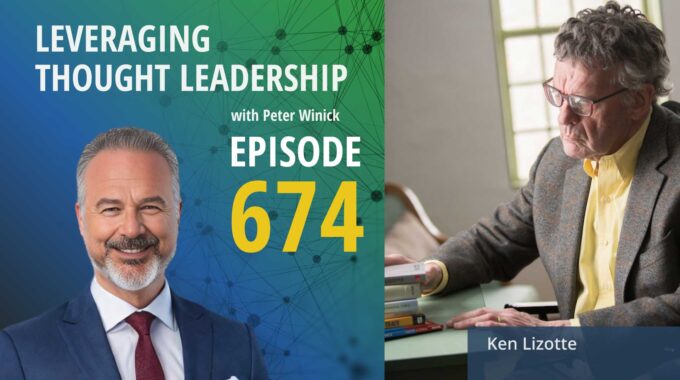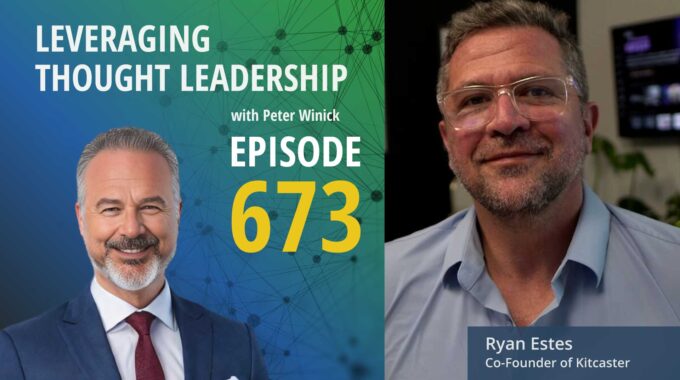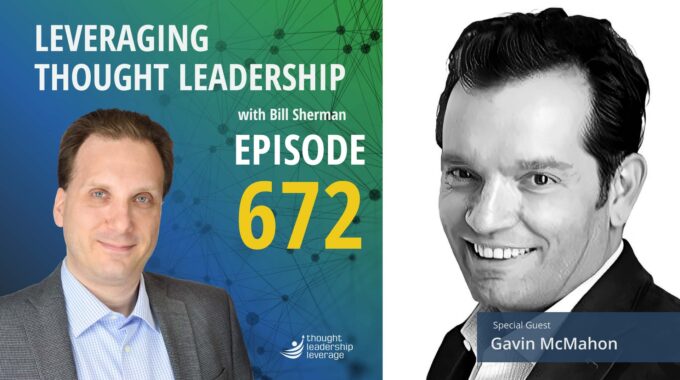Building Brand Love Through Storytelling This episode explores how storytelling can drive inclusion, purpose, and…
Execution at Scale: Why Thought Leadership Drives Results at Mozilla | Suba Vasudevan
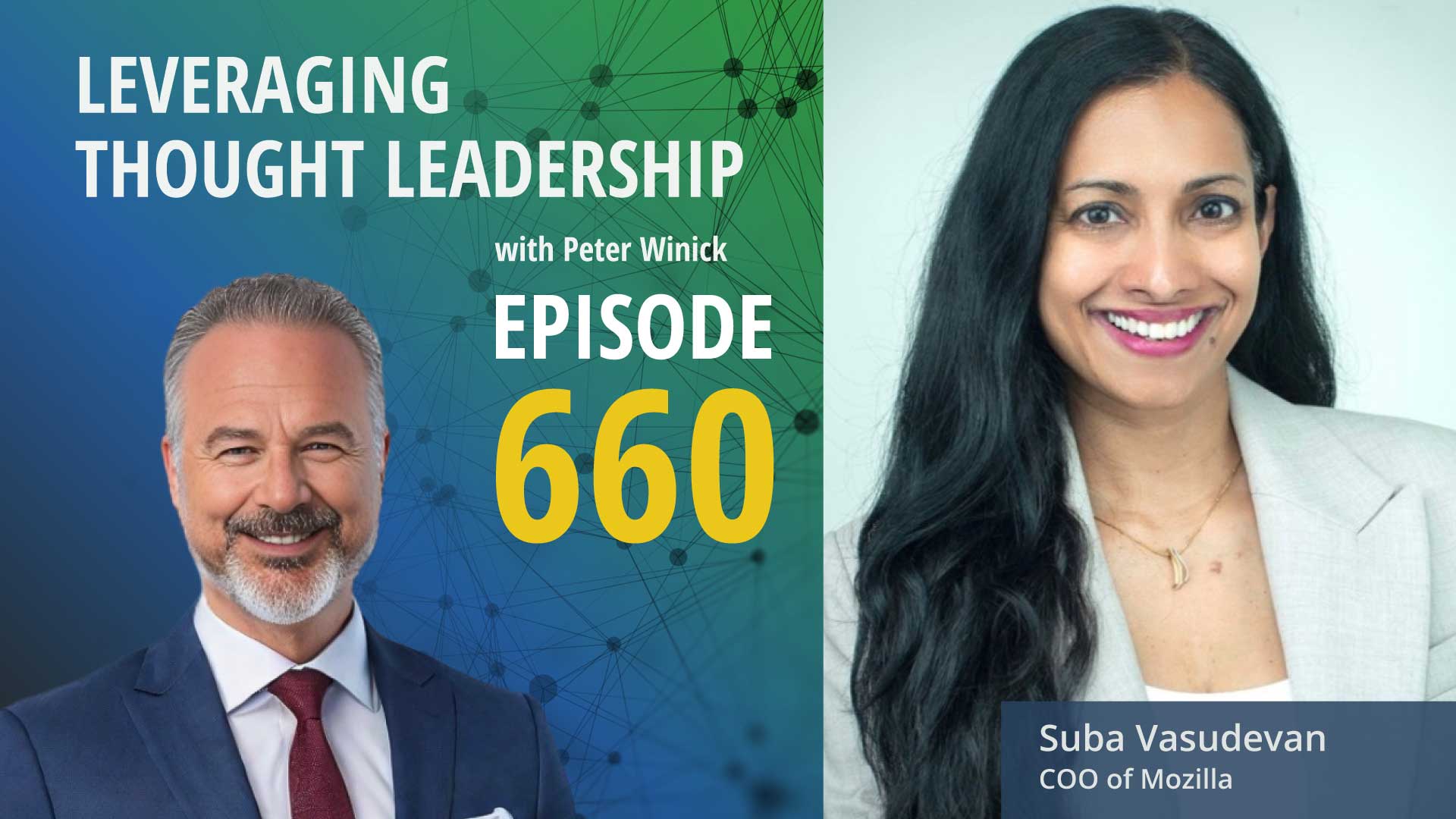
Using Thought Leadership to Drive Strategy, Trust, and Innovation
This episode explores how thought leadership drives real organizational change by aligning culture, strategy, and execution. Learn how leaders can use their voice to build trust, adopt innovation like AI, and scale their impact across teams—not for visibility, but for measurable results.
What does it take to transform a mission-driven organization into a high-velocity execution machine?
Today, Peter Winick sits down with Suba Vasudevan, COO of Mozilla, to explore how thought leadership drives impact inside and outside the organization. Suba isn’t just talking about brand elevation—she’s focused on aligning thought leadership with Mozilla’s double bottom line: financial success and a healthy internet.
You’ll hear how she uses thought leadership to drive strategic clarity, cultural alignment, and real-world execution across a global, mission-focused team. Suba unpacks how leaders can build trust, model transparency, and scale their thinking across a workforce by showing up authentically—whether that’s in a Slack message or on a podcast.
From AI adoption to KPIs, Suba makes it clear: thought leadership isn’t optional for modern executives—it’s core to leading transformation.
She offers a candid look at how leaders should use their voice—not just for visibility, but as a catalyst for cultural change, employee productivity, and long-term innovation.
Suba’s message is simple and powerful: If you’re not investing in thought leadership, you’re holding your team back.
Three Key Takeaways
Thought Leadership Is a Leadership Imperative
Suba emphasizes that thought leadership isn’t optional—it’s foundational to effective leadership in today’s world. It’s how leaders align teams, build trust, and scale their vision across an organization. She views it as table stakes for anyone serious about transformation.
Execution and Culture Must Be Intertwined
Driving results at Mozilla means more than setting KPIs. Suba connects culture to execution, highlighting that metrics only matter when they’re backed by employee belief, buy-in, and shared values. Thought leadership is her tool to bridge that gap.
AI Is a Culture Shift, Not Just a Tech Shift
Suba doesn’t just endorse using AI—she models it. By openly using tools like ChatGPT and encouraging her team to do the same, she’s shaping a culture of innovation, experimentation, and productivity. Her approach shows how leadership can normalize and accelerate change
from the top.
If you found Suba Vasudevan’s episode valuable—especially her take on aligning leadership, culture, and execution—then you won’t want to miss our conversation with Harry Kraemer on Value-Based Thought Leadership.
Like Suba, Harry emphasizes the power of authenticity, clarity, and consistency in leadership. He explores how values-driven decision-making builds trust, scales alignment, and creates long-term impact inside complex organizations. While Suba applies these principles to tech and innovation, Harry brings a timeless leadership lens from his experience as a CEO and professor at Kellogg.
Transcript
Peter Winick And welcome, welcome, Welcome. This is Peter Winick. I’m the founder and CEO at Thought Leadership Leverage. And you’re joining us on the podcast today, which is leveraging thought leadership. I’m excited about today. My guest is Suba Vasudevan. She is the COO of Mozilla. She’s on the board of Mozilla AI. And from a thought leadership perspective, her goal is to transform more to an execution culture. This behemoth of Mozilla that we all know and love. So, anyway, welcome aboard, how are ya?
Suba Vasudevan Thank you, Peter, thank you for having me. I’m a fan of your podcast and I’m excited to be talking on it.
Peter Winick Oh, thank you. So you’re busy, right? You’re a COO, you’ve got an organization to run. There’s lots of things going on. You’re moving a hundred miles an hour, right. And the, and there’s so much change going on AI, et cetera. Why is it that you’ve found the time or creating the time to invest in the thought leadership?
Suba Vasudevan I think that’s super important, right? When I think about leadership itself, it’s two or three things, but one of the most important things is you can be the hero all day long, or you can scale through other people. That’s where thought leadership comes in, in my mind, because the heart of the matter is you’re only here on earth for a certain portion of time, but who is going to carry forward what you have learned and what you are paying forward, what you’re teaching others as a leader, right. That’s why it’s important to create time in general. And then coming and talking on this podcast is a means to doing that. It’s talking about how you take a mission of Mozilla, a company like Mozilla and do it at speed like other big tech companies.
Peter Winick So same more about that, because I think that a lot of C-level executives have a couple of different potential use cases for thought leadership use case one to the public, elevating the brand, telling the story, you know, whatever. And a lot that is professional services, high tech. So it’s not necessarily the monetization, but it’s, it’s getting recalibrating the way people might think about Mozilla people in that context being users, the public investors, et cetera. Second piece of that is internal. I need the, the, team here, the employees here, the folks here to come on this journey for me. And they need to know how I think and where I’m taking them and why we’re doing what I’m doing. I’m sensing it. You’re straddling both of those. Is that a fair?
Suba Vasudevan That’s fair. And I see the two intertwined, right? And that’s what happens when you join a company. So I spent 11 years at Meta. You know, I learned how to execute, be disciplined, apply rigor, et cetera. When you come to apply that execution muscle to a 25-year-old mission, the two become intertwined. Suddenly you’re not beholden to Wall Street. You’re actually doing this because all of the internal employees want to further that mission that the company has off a better, open, healthy internet. How do you do that? You have to bring the two together. On the one hand, you’re transforming the company, but the reason is what all of the employees genuinely believe in and the values that we lead with. And that’s why I’m here talking to you. So how do you gage?
Peter Winick Mozilla, like every tech company, like every company has KPIs and we need to measure things and we to make sure. How do you know it’s working? What are the things that you look at from a, I don’t want to say ROI necessarily, but what are the KPIs, what are the metrics you’re going to say? This is worth me spending X hours a month on versus the, even just from an opportunity cost perspective.
Suba Vasudevan I’ll just explain this really quick. So I straddle two roles, COO of Mozilla.org, which is the holding company at the top. And then I have the role that I mentioned earlier within our corporation where the Firefox browser and a number of other products sit. It’s different for both. That’s where I’m going in response to your question. So at the holding-company level, we think about it, actually for both the portfolio companies and the holding companies, we have to think about double bottom line. So when you mention KPIs, that’s very unique to Mozilla. Double bottom line is when you start thinking about how are you ensuring your profits are going back into a healthy internet, right? And at the same time, how are your profitable? So that’s an interesting, always an interesting conundrum for anyone with a double bottom line type of goals in a more tactical way because you asked me the question on KPIs. It takes the case of the corporation. We have the Firefox browser, we have advertising products, we have a number of other things. We follow like any other tech company, a very rigorous model to set those KPIs, share the board, all of that stuff. That’s table stakes, right? But before you even get there, what’s the direction you’re headed in? Like how do you know that you’re executing well against it? And then how do those KPIS are the ones that matter? That’s the question we tend to ask ourselves. That’s where it takes you all the way from strategy to annual planning, to excellent road mapping. And that’s when your KPIs will start to make sense, right? That’s the second set of philosophy. So double bottom line was one, the whole end-to-end process is a second thing. The third thing is buy-in and culture. That is so important. You can sit there in a corner and set strategy and do annual plans at KPIs all day.
Peter Winick But that’s the hard one, right? So buying culture, we can’t put it on a scale and measure it. We can’t plot it on, I mean, we could, but like, how do you know it’s working? Right? Cause part of what you’re doing is trying to change the culture to transform the business. If they’re not two separate things, they have to go hand in hand.
Suba Vasudevan Yeah, the easy answer I’m going to tell you the easy answer that probably most people will tell you is engagement survey. I think that’s an important tool. And I think it gives us a lot of insights into how employees are feeling, especially if you as a company take it seriously, read everything they’re saying, and take active actions to work against it. Also know in the in the industry, we’ve been told in tech in general in the world, all engagement surveys have dropped across the board. I suppose a little bit of the macro factor. Sure. Set that aside. Set that as a measure of how employees are feeling. If you’re not on the ground with your employees, understanding how they’re feeling on a day-to-day basis, and if every leader is not there on the ground talking to customers, for example, you are going to miss some of the biggest signals. You take all of those signals in, you apply them to your KPIs. By the way, you can get KPIs wrong. I’m sure you’ve seen cases of it. You can easily game the system. How we do it. We make sure that it’s not set up to be gained. But that all of that leads to knowing, are we actually getting this right? Are employees buying into this? Are we doing it for the right reasons, right? That’s it.
Peter Winick Switched to somewhat pragmatic tactical. So I get the big picture on this totally. And you don’t have to sell me. I get it. Right. What does it look like for you tactically? Like what percentage of your time are you spending on this? And what are the types of things that you’re doing that are representative of that? And I would imagine on the second piece, some are killing two birds with one stone when you’re, doing X, you’re adding Y. So fun, additive, but what are things that might be additive? And what percentage of your total time do you wind up spending in this area?
Suba Vasudevan I’m going to say it’s my whole job, but also that of several of my peers. To be very clear, one of my peer who leads Firefox end to end, it’s also his job to think about how Firefox is growing, right? It’s my job to think about our growing revenue. I also work with several other leaders, my peers, to say, how are we improving employee productivity? Let me give you this example. AI at work. Have you read what the Duolingo and Shopify CEOs are put out there? That’s the kind of thing everybody is leaning into. It’s not just those two companies, right? You take AI, forget just using a model at a high level to research things or write things. How do you completely transform an employee base and how they work at work on a day-to-day basis? Those are the kinds of long-term things I work with other people to think about. It’s a large part of my job, and that is going to lead to more creativity, more innovation, more productivity. And by the way, Peter, if someone tells you it’s an efficiency play, push back on them. It’s not an efficiency way only.
Peter Winick If you’re enjoying this episode of Leveraging Thought Leadership, please make sure to subscribe. If you’d like to help spread the word about our podcast, please leave a five-star review at ratethispodcast.com/LTL and share it with your friends. We’re available on Apple Podcasts and on all major listening apps, as well as at thoughtleadershipleverage.com/podcast. Say more about that.
Suba Vasudevan You know, when I think about it, like, I don’t know how, do you use a lot of LLMs or AI tools for your data?
Peter Winick In the last four or five months, yes. Yeah. So why do that sort of just curious, I wouldn’t say, I mean, my level of proficiency or expertise is pretty light, but I’m a convert. Like I’ve seen, I’m like, wow. And I’ve see other people that are doing it far more than I am based on their roles. And I keep telling myself on the one hand, wow, this is like the dial-up days of the internet with AOL, and simultaneously it’s mind blowing. So.
Suba Vasudevan It is, you know, it’s a great analogy. It’s also equal to what automation did for various industries way back when, as we all know it. It can be scary. So part of it is how do you bring an employee base along? So Mozilla has been doing that into acceptance and leaning in. And then right now we’re entering the phase of how do actually set the tone on is it okay to use it for performance reviews? So for example, you asked me to say more. I’ve been telling my team, Hey, I wrote up this whole thing on chat GPT. You should as well. I’ve said this for six months now, because I’ve been using it for at least a year and a half, two years. I’ve been using various tools. I now openly stand there and say it, shout out from the rooftops when I’m using any tool so that it’s empowering the teams and giving them permission to do the same, right? You don’t want it to be a stigma. And every time I see something that’s clearly say written by a tool like ChatGPT or researched by a tool, and it makes sense to me, I’m providing positive reinforcement.
Peter Winick So we’re asking what I think also culturally. If you’re modeling it’s any other behavior, this is an adoption of a tool, but there’s a cultural implication here. And if Sue is doing it, geez, how am I not right? Like
Suba Vasudevan That’s it. You want a leader to be the one who’s saying move the stigma. I sat down with someone last week, actually, and showed them how to create their own LLM to make business reviews for the KPI OKR process easier. And it was mind blowing, right? And I asked this person to record her own experiences as she does it for herself. And then I want to scale that training out to everybody because you want people who can do this everywhere. And become the little allies or focal point for their peers and friends in the company.
Peter Winick Love it, love it. So let’s go down a little bit of a different path. A lot of thought leadership, particularly when we’re trying to resonate, get a message to resonate with our team and our employees is trial and error. Like when you’re doing a presentation to the board, you’ve got to have your ducks in a row, right? Like you’ve gotta have your spreadsheet, you gotta have everything, this is our, like that’s not a place to be squishy. But with this, you can try things out, See how they land. Modify it, adjust it, how do you iterate in a way that doesn’t have people thinking, uh-oh, this is flavor of the month, and every, you know, like, you gotta stay on point, but you gotta iterate. How do you manage that?
Suba Vasudevan I, you know, we live in a world where I genuinely believe people value authenticity. Like, let’s take the case of this podcast. You and I are just doing this on the fly. We’re having a conversation, right? That’s what people value is, are you overprepared? Are you telling me something that’s off of a playbook or how are you coming across in a way that’s truly real? And that’s true. The minute you do that, I think it’s a huge unlock along with it. And I’ll share what I think I’ve shared this with you. When we had our intro college, you are, and you’re vulnerable, you know, take the case of open source, which is Mozilla, but also take the case of vulnerability in a leader. There is a parallel. You’re putting your ego on the line. Just like you’re putting you’re code on the line for it to receive feedback. And we poke that. You’re, putting yourself on the line for feedback and you need to be as a leader, open to it. That’s the thing. And I have employees slack me all the time saying, Hey, I like this. Or maybe less of that. And I’m like, great, tell me more. What can I do better or what’s working for you?
Peter Winick Stay there a minute because in many organizations today, and in most organizations, 20, 25 years ago, Hey, we didn’t have slack, but give it, having a means to communicate directly to a C level exec and saying, Hey I don’t agree with you. That would be a career killing moment. Yeah. That would not be wise, but you’ve actually created, you know, an environment, a culture that says This is not only she open to this, she encourages this. She wants this and there would never be a negative ramification, right? Because sometimes companies say, Oh, give us the feedback on it. It’s like, Oh you’re a whiner or you get labeled or you get like whatever. So that in and of itself, I think is, is transformative right there.
Suba Vasudevan It is, it’s the, going back to your question on culture, how do you transform cultures? It’s the macro stuff I laid out earlier, but it’s also these micro types of moments, right? Just on that point you mentioned earlier, something occurred to me. There’s a cultural element here. Look, I come from India. I know what Indian culture is like, right, growing up there. I moved here 20 something years ago and I’ve, I think learned a lot of this culture as well and assimilated both. But when I was at Metta, I had a massively global team all over the world. And I didn’t always get the feedback that I needed from people sitting in Singapore or Hyderabad or some of these other countries, right? And I had to actually wear the hat, my old growing up hack and say, why am I not getting that feedback? It’s probably because it’s a little bit still taboo in Asian cultures. I’m not generalizing, but it’s not that easy for someone to give your boss or a skip, skip level boss feedback. That’s, you know, an opportunity for growth for the.
Peter Winick What I would add to that, yeah, there’s a cultural piece, but I think it’s compounded today in that many of us have work colleagues that we’ve never had a meal with, right? If someone’s in different cities and we don’t see each other. So there’s the trust piece. There’s the collaborative piece. There’s, you know, it’s easier to say to a colleague that you sit next to have lunch with, go, go hiking with whatever. Hey, when you said that in the meeting, you kind of look like an idiot. But if there’s, a cultural peace and you’re halfway around the world and there’s time differences and we’ve ever broken breath. It’s like, Oh, and by the way, sometimes things come across poorly in a Slack or a text or whatever, they don’t know where it’s coming from, you know? And they read it 17 times and they’re freaked out. So I think there’s a lot of variables there.
Suba Vasudevan Oh, words on a screen are very different from words in person, right? And so I made it a point, this was pre-COVID for many, many years, to visit my offices where people were and actually sit down, whether it was small group lunches, I had something called office hours. Those were things that really helped connect with people one-on-one. Even 15 minutes, if you have a large group, makes a difference. We had a leadership summit here at Mozilla a couple of months ago where we had all of the directors and above. You know, meet in person, it was game changer. I, so many long-term resilience engineers from Europe, you know who maybe had a different stance than me on various different topics for the first time and having lunch with folks who are working in breakout groups, completely changed the tone. Now when they ping me or email me or say something in a group slack, oh yeah, I met you, I know what you mean, I got this, it’s very different and I hope everybody feels the same, you know after moments like these, it is important.
Peter Winick Yeah. And again, that’s a cultural piece in this remote work, you know, in by you know we are not living in an age of everybody’s in the same office and you know whatever management by walking around kind of thing. It’s well, how do you what’s the digital equivalent of walking around?
Suba Vasudevan Or management by appointment. I hear that was a-
Peter Winick Yeah. Well, I think that’s, that’s true. As we start to wrap, what I would ask is let’s assume listening today, because typically there are, there’s a handful, maybe more of C-level executives that have been toying with thinking about pondering, delaying the investment of time, energy, and effort into thought leadership to drive their business results and outcomes. How would you convince them or assure them that it’s a wise thing to do?
Suba Vasudevan Yeah, I, you know, for me, it’s table stakes as a leader to invest in thought leadership. Like, let’s just go there. If you’re not doing that, you’re never going to be that successful as a leader in today’s day and age, right? It is a tool for alignment. Like we just talked about, it is a tool for building trust and it’s not a weakness. Like that is the one thing I could not underline enough. The importance of your thought leadership as a human being, the importance of having these conversations. Is what’s going to give employee bases, it’s what’s gonna give your work, the clarity and the execution focus that people need to succeed. So I would say every leader needs to invest in it.
Peter Winick I love it. Thank you for that. Great to talk to you. I appreciate your candor and your transparency and big fan. Thank you so much, Suba.
Suba Vasudevan Thank you Peter, it was good to talk to you.
Peter Winick To learn more about Thought Leadership Leverage, please visit our website at thoughtleadershipleverage.com. To reach me directly, feel free to email me at peter at thoughtleadershipleverage.com, and please subscribe to Leveraging Thought Leadership on iTunes or your favorite podcast app to get your weekly episode automatically.


